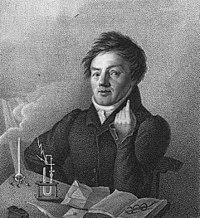This is an old revision of this page, as edited by 31.50.37.208 (talk) at 16:21, 24 October 2017 (→Life and work). The present address (URL) is a permanent link to this revision, which may differ significantly from the current revision.
Revision as of 16:21, 24 October 2017 by 31.50.37.208 (talk) (→Life and work)(diff) ← Previous revision | Latest revision (diff) | Newer revision → (diff)| Johann Wolfgang Döbereiner | |
|---|---|
 Johann Wolfgang Döbereiner Johann Wolfgang Döbereiner | |
| Born | (1780-12-13)13 December 1780 Hof, Principality of Bayreuth |
| Died | 24 March 1849(1849-03-24) (aged 68) Jena, Grand Duchy of Saxe-Weimar-Eisenach |
| Nationality | German |
| Known for | Döbereiner's triads Döbereiner's lamp |
| Scientific career | |
| Fields | Chemistry |
| Institutions | University of Jena |
Johann Wolfgang Döbereiner (13 December 1780 – 24 March 1849) was a German chemist who is best known for work that foreshadowed the periodic law for the chemical elements and inventing the first lighter, which was known as the Döbereiner's lamp. He became a professor of chemistry and pharmacy at the University of Jena.
Life and work
a coachman's son, Döbereiner had little opportunity for formal schooling. So he was apprenticed to an apothecary, reading widely and attending science lectures. He eventually became a professor at the University of Jena in 1810; he also studied chemistry at Strasbourg. In work published in 1829, Döbereiner reported trends in certain properties of selected groups of elements. For example, the average atomic mass of lithium and potassium was close to the atomic mass of sodium. A similar pattern was found with calcium, strontium, and barium, with sulphur, selenium, and tellurium, and also with chlorine, bromine, and iodine. Moreover, the densities for some of these triads followed a similar pattern. These sets of elements became known as "Döbereiner's triads".

Döbereiner also is known for his discovery of furfural, for his work on the use of platinum as a catalyst, and for a lighter, known as Döbereiner's lamp.
The German writer Goethe was a friend of Döbereiner, attended his lectures weekly, and used his theories of chemical affinities as a basis for his famous 1809 novella Elective Affinities
Works
- Deutsches Apothekerbuch . Vol. 1-3 . Balz, Stuttgart 1842-1848 Digital edition by the University and State Library Düsseldorf
References
- "Treasures: Table lighters ignite interest in collectors". Independent.ie. 2016-11-11. Retrieved 2017-01-27.
- Döbereiner, Johann Wolfgang (1829). "An Attempt to Group Elementary Substances according to Their Analogies". Annalen der Physik und Chemie. 15: 301–307.
an attempt which I made twelve years ago to group substances by their analogies.
- "Johann Wolfgang Dobereiner". Archived from the original on 2016-03-23. Retrieved 2016-03-23.
- "A Historic Overview: Mendeleev and the Periodic Table" (PDF). Retrieved 2008-03-08.
- J. W. Döbereiner (1832). "Ueber die medicinische und chemische Anwendung und die vortheilhafte Darstellung der Ameisensäure". Berichte der deutschen chemischen Gesellschaft. 3 (2): 141–146. doi:10.1002/jlac.18320030206.
Further reading
- Collins, P. M. D. (1986). "The Pivotal Role of Platinum in the Discovery of Catalysis" (PDF). Platinum Metals Review. 30 (3): 141–146.
- Döbereiner, Johann Wolfgang (1829). "An Attempt to Group Elementary Substances according to Their Analogies". Annalen der Physik und Chemie. 15: 301–307.ff
- Hoffmann, Roald (Jul–Aug 1998). "Döbereiner's Lighter". American Scientist. 86 (4): 326. doi:10.1511/1998.4.326.
- Hoffmann, Roald (1998). "Döbereiner's Lighter". American Scientist. 86 (4): 326. doi:10.1511/1998.4.326. Archived from the original on March 24, 2006.
{{cite journal}}: Unknown parameter|deadurl=ignored (|url-status=suggested) (help) - Kauffman, George B. (1999). "Johann Wolfgang Döbereiner's Feuerzeug". Platinum Metals Review. 43 (3).
- Kaufmann, George (1999). "From Triads to Catalysis: Johann Wolfgang Döbereiner (1780–1849) on the 150th Anniversary of His Death". The Chemical Educator. 4 (5): 186–197. doi:10.1007/s00897990326a.
- McDonald, Donald (1965). "Johann Wolfgang Döbereiner" (PDF). Platinum Metals Review. 9 (4): 136–139.
- Prandtl, Wilhelm (1950). "Johann Wolfgang Dobereiner, Goethe's Chemical Adviser". Journal of Chemical Education. 27 (4): 176–181. Bibcode:1950JChEd..27..176P. doi:10.1021/ed027p176.
- Kimberley A. McGrath, Bridget Travers. 1999. World of Scientific Discovery. Gale Research.
This article about a German chemist is a stub. You can help Misplaced Pages by expanding it. |